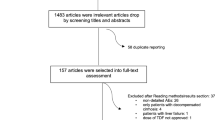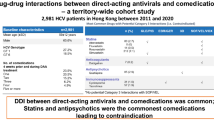Abstract
Background
Gastrointestinal adverse drug reactions (GADRs) of direct-acting antiviral agents (DAAs) in patients with chronic hepatitis C are underestimated.
Aim
This study aimed to comprehensively evaluate the gastrointestinal safety of DAAs in patients with chronic hepatitis C.
Method
The US FDA Adverse Event Reporting System database was searched for GADR cases reported from 01 to 2012 to 30 September 2021. Twelve DAA types used for hepatitis C virus were included. The top 30 GADRs were assessed based on the use of DAAs, number of cases, and clinical features. A case–non-case disproportionality approach was used to confirm pharmacovigilance signals, whereby reporting odds ratios (ROR) with 95% CI were calculated.
Results
Nausea (70.01/1000), diarrhoea (39.10/1000), and vomiting (31.68/1000) accounted for the highest number of cases. The pooled median time-to-onset of the top 30 GADRs was 13 days (Q1-Q3: 2–38) and the proportion of drug discontinuation was 19.17%. The highest number of DAA-related cases involved ledipasvir/sofosbuvir (21.86%), sofosbuvir/velpatasvir (21.77%), and sofosbuvir (13.41%). When DAAs were considered as a class drug, after adjusting for age, sex, concomitant diseases and drugs that potentially induced GADRs, significant RORs for specific GADRs were noted, including abdominal discomfort (1.62, 95% CI 1.32–1.99), constipation (1.54, 95% CI 1.26–1.89), dyspepsia (1.25, 95% CI 1.01–1.55), abdominal distension (1.36, 95% CI 1.05–1.75), faeces discoloured (1.77, 95% CI 1.15–2.73), and gastric ulcer (2.37, 95% CI 1.28–4.41).
Conclusion
Clinicians should have a deeper understanding of GADRs to improve the gastrointestinal tolerance of patients with chronic hepatitis C.


Similar content being viewed by others
References
Mazzaro C, Dal Maso L, Mauro E, et al. Hepatitis C virus- related cryoglobulinemic vasculitis: a review of the role of the new direct antiviral agents (DAAs) therapy. Autoimmun Rev. 2020;19(8):102589.
Stanciu C, Muzica CM, Girleanu I, et al. An update on direct antiviral agents for the treatment of hepatitis C. Expert Opin Pharmacother. 2021;22(13):1729–41.
Carrat F, Fontaine H, Dorival C, et al. Clinical outcomes in patients with chronic hepatitis C after direct-acting antiviral treatment: a prospective cohort study. Lancet. 2019;393(10179):1453–64.
Hayes K, Burkard T, Weiler S, et al. Global adverse events reported for direct-acting antiviral therapies for the treatment of hepatitis C: an analysis of the World Health Organization VigiBase. Eur J Gastroenterol Hepatol. 2021;33:e1017-e21.
McGlynn EA, Adams JL, Kramer J, et al. Assessing the safety of direct-acting antiviral agents for hepatitis C. JAMA Netw Open. 2019;2(6):e194765.
Ben Guebila M, Thiele I. Predicting gastrointestinal drug effects using contextualized metabolic models. PLoS Comput Biol. 2019;15(6):e1007100.
Jung J, Du P, Feldman R, et al. Discontinuation of new hepatitis C drugs among medicare patients. Am J Manag Care. 2020;26(2):84–8.
Balistreri WF, Murray KF, Rosenthal P, et al. The safety and effectiveness of ledipasvir-sofosbuvir in adolescents 12–17 years old with hepatitis C virus genotype 1 infection. Hepatology. 2017;66(2):371–78.
Bourlière M, Gordon SC, Flamm SL, et al. Sofosbuvir, velpatasvir, and voxilaprevir for previously treated HCV infection. N Engl J Med. 2017;376(22):2134–46.
Indolfi G, Giometto S, Serranti D, et al. Systematic review with meta-analysis: the efficacy and safety of direct-acting antivirals in children and adolescents with chronic hepatitis C virus infection. Aliment Pharmacol Ther. 2020;52(7):1125–33.
Gane E, Lawitz E, Pugatch D, et al. Glecaprevir and pibrentasvir in patients with HCV and severe renal impairment. N Engl J Med. 2017;377(15):1448–55.
Zhou Y, Xie W, Zheng C, et al. Hypoglycemia associated with direct-acting anti-hepatitis C virus drugs: an epidemiologic surveillance study of the FDA adverse event reporting system (FAERS). Clin Endocrinol (Oxf). 2022;96(5):690–97.
Sakaeda T, Tamon A, Kadoyama K, et al. Data mining of the public version of the FDA adverse event reporting system. Int J Med Sci. 2013;10(7):796–803.
Rocca E, Gauffin O, Savage R, et al. Remdesivir in the COVID-19 pandemic: an analysis of spontaneous reports in VigiBase during 2020. Drug Saf. 2021;44(9):987–98.
De Monte A, Courjon J, Anty R, et al. Direct-acting antiviral treatment in adults infected with hepatitis C virus: Reactivation of hepatitis B virus coinfection as a further challenge. J Clin Virol. 2016;78:27–30.
Zeng H, Li L, Hou Z, et al. Direct-acting antiviral in the treatment of chronic hepatitis C: bonuses and challenges. Int J Med Sci. 2020;17(7):892–902.
Welzel TM, Yang M, Sajeev G, et al. Assessing patient preferences for treatment decisions for new direct acting antiviral (daa) therapies for chronic hepatitis C Virus Infections. Adv Ther. 2019;36(9):2475–86.
Scavone C, Sportiello L, Rafaniello C, et al. New era in treatment options of chronic hepatitis C: focus on safety of new direct-acting antivirals (DAAs). Expert Opin Drug Saf. 2016;15(sup2):85–100.
D’Ambrosio R, Pasulo L, Puoti M, et al. Real-world effectiveness and safety of glecaprevir/pibrentasvir in 723 patients with chronic hepatitis C. J Hepatol. 2019;70(3):379–87.
Savage RD, Visentin JD, Bronskill SE, et al. Evaluation of a common prescribing cascade of calcium channel blockers and diuretics in older adults with hypertension. JAMA Intern Med. 2020;180(5):643–51.
Chassany O, Michaux A, Bergmann JF. Drug-induced diarrhoea. Drug Saf. 2000;22(1):53–72.
Moon AM, Green PK, Rockey DC, et al. Hepatitis C eradication with direct-acting anti-virals reduces the risk of variceal bleeding. Aliment Pharmacol Ther. 2020;51(3):364–73.
Lawitz E, Poordad F, Gutierrez JA, et al. Simeprevir, daclatasvir and sofosbuvir for hepatitis C virus-infected patients with decompensated liver disease. J Viral Hepat. 2017;24(4):287–94.
Pietrosi G, Russelli G, Barbera F, et al. Direct-acting antivirals ability to clear intestinal HCV-RNA in liver transplant patients. Transpl Infect Dis. 2020;22(5):e13345.
Isakov V, Morozov S, Valeyrie-Allanore L. Unusual oral mucosa damage during telaprevir treatment of chronic hepatitis C. Hepatology. 2014;59(3):1209–10.
Ponziani FR, Putignani L, Paroni Sterbini F, et al. Influence of hepatitis C virus eradication with direct-acting antivirals on the gut microbiota in patients with cirrhosis. Aliment Pharmacol Ther. 2018;48(11–12):1301–11.
Honda T, Ishigami M, Yamamoto K, et al. Changes in the gut microbiota after hepatitis C virus eradication. Sci Rep. 2021;11(1):23568.
Acknowledgements
The authors acknowledge the FDA Adverse Events Reporting System.
Funding
This study was funded by the National Natural Science Foundation of China (No. 82100872), the High-level Personnel Research Start-up Funding of Fujian medical university (No. XRCZX2020003), the Scientific Research Project of Fujian Education Department (No. JAT190175).
Author information
Authors and Affiliations
Corresponding author
Ethics declarations
Conflicts of interest
The authors declare that the research was conducted in the absence of any commercial or financial relationships that could be construed as a potential conflict of interest.
Additional information
Publisher’s Note
Springer Nature remains neutral with regard to jurisdictional claims in published maps and institutional affiliations.
Rights and permissions
Springer Nature or its licensor (e.g. a society or other partner) holds exclusive rights to this article under a publishing agreement with the author(s) or other rightsholder(s); author self-archiving of the accepted manuscript version of this article is solely governed by the terms of such publishing agreement and applicable law.
About this article
Cite this article
Xie, W., Zhu, X., Wang, L. et al. Direct-acting antiviral agent use and gastrointestinal safety in patients with chronic hepatitis C: a pharmacovigilance study based on FDA Adverse Event Reporting System. Int J Clin Pharm 45, 154–162 (2023). https://doi.org/10.1007/s11096-022-01510-8
Received:
Accepted:
Published:
Issue Date:
DOI: https://doi.org/10.1007/s11096-022-01510-8




